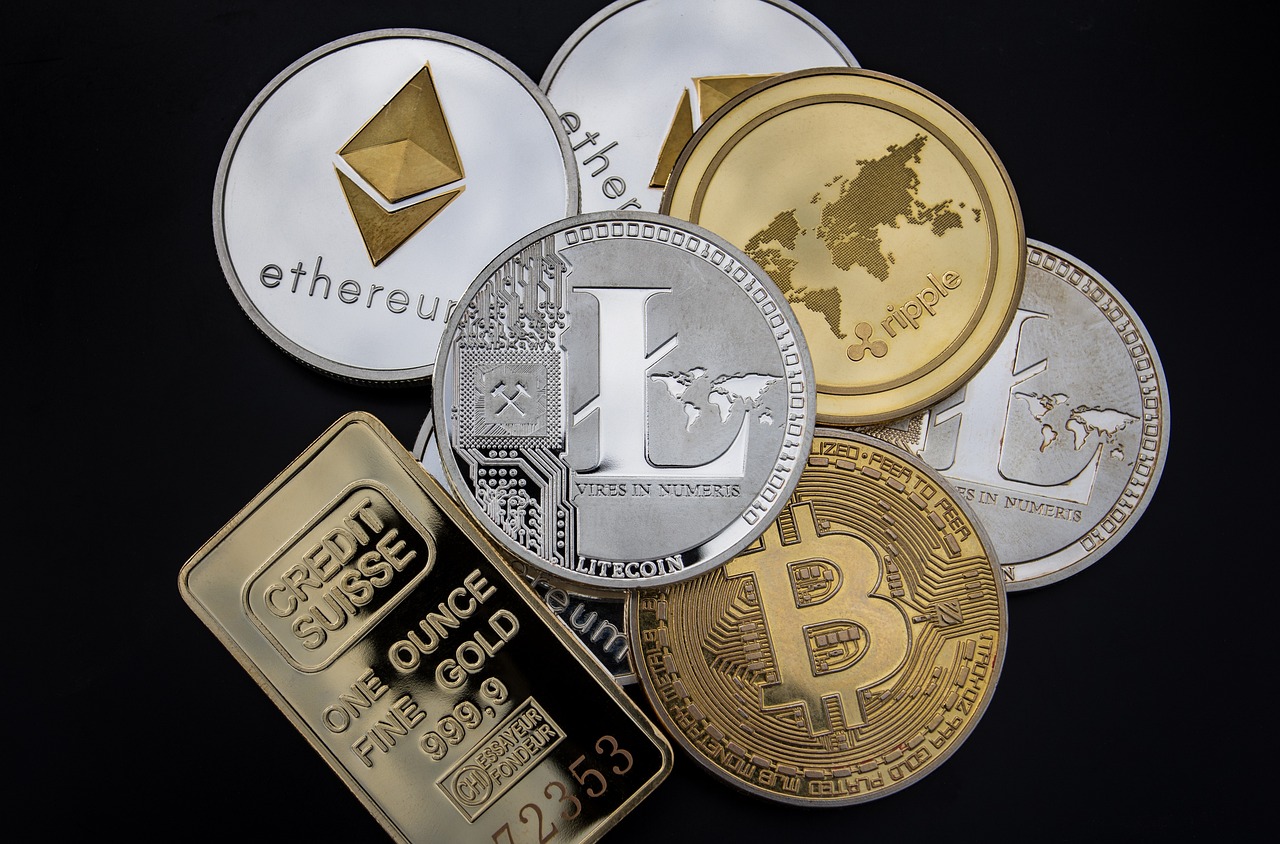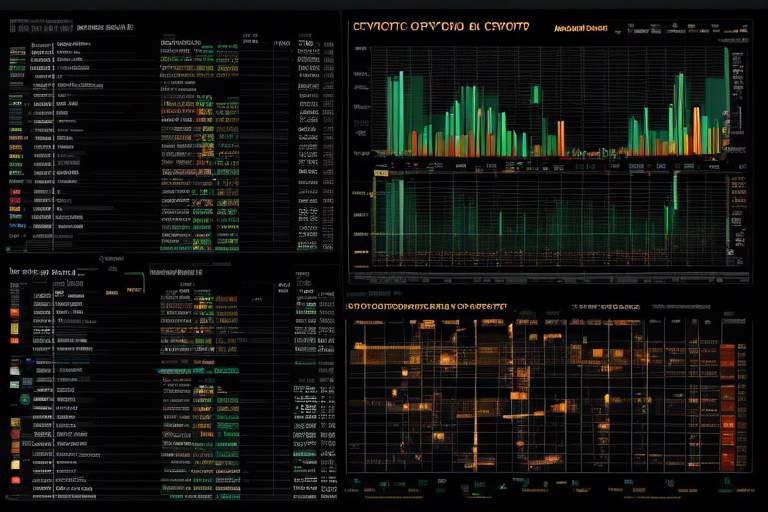Understanding the Impact of Market Cap on Altcoin Prices
In the ever-evolving world of cryptocurrencies, understanding how market capitalization impacts altcoin prices is crucial for anyone looking to navigate this volatile landscape. Market capitalization, often referred to as market cap, is a key indicator of a cryptocurrency's overall value. It is calculated by multiplying the total supply of coins by the current price per coin. This simple formula, however, opens up a Pandora's box of insights into how altcoins are valued and traded.
When you think about market cap, imagine it as the weight class of a boxer. Just as heavier boxers often have different strategies and risks compared to lighter ones, cryptocurrencies with varying market caps behave differently in the market. Large-cap altcoins, such as Bitcoin and Ethereum, are generally more stable and less susceptible to sudden price swings. On the other hand, small-cap altcoins can be more volatile, offering both exciting investment opportunities and significant risks. Understanding these dynamics can help investors make informed decisions that align with their risk tolerance and investment goals.
Moreover, market cap isn't just a number; it reflects investor sentiment and the perceived value of a cryptocurrency. For instance, when a small-cap altcoin gains traction and begins to attract attention, its market cap can grow rapidly, leading to price spikes. Conversely, if a large-cap coin faces negative news or regulatory scrutiny, its market cap may shrink, impacting its price significantly. Thus, market cap serves as a barometer for investor confidence and market trends.
In the following sections, we will dive deeper into how market cap influences price volatility, the distinctions between large-cap and small-cap altcoins, and the psychological factors that drive investor behavior. By the end of this exploration, you'll have a clearer understanding of how to leverage market cap insights in your altcoin investment strategy.
Market capitalization is a fundamental metric in the cryptocurrency world, representing the total market value of a cryptocurrency. Understanding its calculation and significance is crucial for evaluating altcoin investments.
Market cap plays a significant role in the price volatility of altcoins. This section discusses the relationship between market cap size and price fluctuations, highlighting the risks and opportunities for investors.
The distinction between large-cap and small-cap altcoins is essential for investors. This segment examines the characteristics of each category and their respective impacts on price stability and growth potential.
Investing in large-cap altcoins often involves different strategies compared to smaller counterparts. This subsection outlines effective approaches for capitalizing on the stability and liquidity of large-cap cryptocurrencies.
Small-cap altcoins present unique opportunities for high returns but come with increased risk. This part discusses how to identify promising small-cap investments and manage associated risks.
Market sentiment significantly influences altcoin prices, often swaying them independently of market cap. This section delves into the psychological factors that drive investor behavior and price movements.
The relationship between market cap and adoption rates is critical for understanding altcoin viability. This section explores how increased adoption can lead to market cap growth and price appreciation.
Analyzing successful altcoins provides insights into how market cap and other factors contributed to their rise. This segment presents case studies highlighting key lessons for potential investors.
Studying failed altcoins reveals the pitfalls associated with market cap mismanagement. This part discusses notable failures and the warning signs investors should watch for in the altcoin market.
- What is the significance of market cap in cryptocurrency?
Market cap helps investors assess the size and stability of a cryptocurrency, influencing investment decisions. - How can market cap affect an altcoin's price?
A higher market cap typically indicates more stability, while lower market caps can lead to higher volatility and risk. - Are small-cap altcoins worth the risk?
Yes, they can offer high returns, but investors should conduct thorough research and be aware of the risks involved. - How does market sentiment impact prices?
Market sentiment can drive price movements based on investor emotions and perceptions, sometimes independent of fundamental factors.

The Basics of Market Capitalization
Market capitalization, often referred to as "market cap," is a crucial metric in the cryptocurrency universe, serving as a barometer for the total market value of a cryptocurrency. Understanding market cap is essential for anyone looking to navigate the complex waters of altcoin investments. Simply put, market cap is calculated by multiplying the current price of a cryptocurrency by its total circulating supply. For example, if an altcoin is priced at $10 and there are 1 million coins in circulation, the market cap would be $10 million. This straightforward calculation provides a snapshot of the cryptocurrency's overall value and its standing in the market.
The significance of market cap extends beyond mere numbers; it plays a pivotal role in shaping investor perceptions and decisions. A higher market cap often signals a more established and stable cryptocurrency, while a lower market cap can indicate a higher risk, but also the potential for greater rewards. This duality makes market cap a double-edged sword in the realm of altcoins.
When evaluating altcoins, it's essential to categorize them based on their market cap. Generally, cryptocurrencies are classified into three main categories:
- Large-cap cryptocurrencies: These are typically well-established coins with a market cap exceeding $10 billion. They tend to be more stable and less volatile.
- Mid-cap cryptocurrencies: Falling between $1 billion and $10 billion in market cap, these coins can offer a balance of stability and growth potential.
- Small-cap cryptocurrencies: With a market cap below $1 billion, these altcoins can be highly volatile but may present unique opportunities for significant returns.
Understanding the basics of market capitalization is not just about grasping a number; it's about recognizing its implications for investment strategies. For instance, large-cap cryptocurrencies often attract institutional investors due to their perceived stability, while small-cap coins may entice individual investors seeking high-risk, high-reward opportunities. This dynamic creates a diverse investment landscape where both risk-takers and conservative investors can find their niche.
Furthermore, market cap can influence liquidity, which is the ease with which an asset can be bought or sold without affecting its price. Larger market cap cryptocurrencies generally enjoy higher liquidity, making it easier for investors to enter and exit positions. In contrast, small-cap cryptocurrencies may face liquidity challenges, potentially leading to more significant price swings when large trades occur.
In summary, understanding market capitalization is fundamental for anyone looking to invest in altcoins. It provides insights into the stability, risk, and potential growth of various cryptocurrencies. As you venture into the world of altcoin investments, grasping the basics of market cap will empower you to make informed decisions and navigate the ever-evolving cryptocurrency landscape.
- What is the formula for calculating market capitalization?
Market cap is calculated by multiplying the current price of the cryptocurrency by its total circulating supply. - Why is market cap important in cryptocurrency investing?
Market cap helps investors gauge the size and stability of a cryptocurrency, influencing their investment decisions and strategies. - How does market cap affect price volatility?
Generally, larger market cap cryptocurrencies are less volatile than smaller ones, which can experience significant price swings. - Can small-cap altcoins be good investments?
Yes, small-cap altcoins can offer high returns, but they come with increased risk and volatility.

How Market Cap Affects Price Volatility
Market capitalization, often referred to as market cap, is more than just a number; it serves as a crucial indicator of an altcoin's potential and stability. When we talk about price volatility, we are essentially discussing how much the price of an altcoin can swing within a given timeframe. Understanding the relationship between market cap and price volatility is vital for both seasoned investors and newcomers alike.
To put it simply, the size of a cryptocurrency's market cap can significantly influence how its price behaves. Generally, larger market cap altcoins tend to exhibit less volatility compared to smaller ones. This is largely because they have a more substantial investor base and higher liquidity. Think of it this way: if you have a massive ocean (large-cap altcoins), it takes a lot more force to create waves compared to a small pond (small-cap altcoins) where even a light breeze can cause ripples. This analogy holds true in the crypto market as well.
Investors often find themselves asking, "Why does this matter?" Well, understanding price volatility is crucial for making informed decisions. If you're investing in a small-cap altcoin, you may experience dramatic price swings that can lead to both significant gains and steep losses. Conversely, large-cap altcoins tend to provide a more stable investment environment, which can be appealing for those looking to minimize risk.
Here’s a quick breakdown of how market cap influences price volatility:
- Larger Market Caps: Typically, these altcoins have a more extensive network of users and investors, leading to reduced price fluctuations. For example, Bitcoin and Ethereum often show more resilience against market shocks.
- Smaller Market Caps: These altcoins can be susceptible to rapid price changes due to lower trading volumes. A single large trade can significantly impact the price, creating opportunities but also risks for investors.
- Market Sentiment: Regardless of market cap, investor sentiment can cause price swings. Positive news can drive prices up, while negative news can cause them to plummet, often irrespective of market cap size.
Moreover, market cap also interacts with other factors like trading volume and market sentiment. For instance, a large-cap altcoin that suddenly sees a spike in trading volume may experience a price surge, while a small-cap altcoin could face a dramatic downturn if a few investors decide to cash out simultaneously. This interplay can create a complex web of price dynamics that investors must navigate.
In conclusion, understanding how market cap affects price volatility is essential for anyone looking to invest in altcoins. It helps you gauge not only the potential risks but also the opportunities that come with investing in different categories of cryptocurrencies. By keeping an eye on market cap alongside other factors, you can make more informed decisions and potentially capitalize on the ever-changing landscape of the altcoin market.

Large Cap vs. Small Cap Altcoins
When diving into the world of altcoins, one of the first distinctions you’ll encounter is between large-cap and small-cap cryptocurrencies. Understanding this difference is crucial for any investor looking to navigate the often turbulent waters of the crypto market. But what exactly does it mean? In simple terms, the market capitalization (or market cap) of a cryptocurrency is calculated by multiplying the current price of the coin by the total number of coins in circulation. This figure gives investors an idea of the relative size and stability of a cryptocurrency.
Large-cap altcoins, typically defined as those with a market cap exceeding $10 billion, tend to be more established and less volatile than their small-cap counterparts. Coins like Ethereum and Ripple fall into this category. These cryptocurrencies often have a solid user base and widespread adoption, which can lead to greater price stability. For investors, this means a lower risk of drastic price swings, making large-cap altcoins an attractive option for those looking for a more secure investment. However, the trade-off is that the potential for exponential growth is often limited.
On the flip side, small-cap altcoins, generally characterized by a market cap under $1 billion, present a different set of dynamics. These coins are often newer and less established, which means they can be highly volatile. The allure of small-cap altcoins lies in their potential for significant returns. For example, if a small-cap coin gains traction and achieves broader adoption, the price can skyrocket, leading to substantial profits for early investors. However, this potential comes with increased risks, including the possibility of failure or extreme price fluctuations.
To illustrate the differences between large-cap and small-cap altcoins, let’s take a look at the following table:
| Feature | Large Cap Altcoins | Small Cap Altcoins |
|---|---|---|
| Market Cap | Over $10 billion | Under $1 billion |
| Price Stability | More stable | Highly volatile |
| Growth Potential | Limited | High |
| Investment Risk | Lower risk | Higher risk |
In summary, the choice between investing in large-cap and small-cap altcoins ultimately depends on your risk tolerance and investment strategy. If you're looking for a safer bet with more predictable returns, large-cap altcoins may be the way to go. However, if you're willing to embrace the risks for the chance of higher rewards, then small-cap altcoins could be your ticket to substantial gains. Remember, every investment comes with its own set of risks and rewards, so it's essential to do your research and make informed decisions.
- What is market capitalization? - Market capitalization refers to the total market value of a cryptocurrency, calculated by multiplying the coin's current price by the total number of coins in circulation.
- Why do large-cap altcoins tend to be more stable? - Large-cap altcoins are often more established with a larger user base, leading to greater price stability and lower volatility.
- Can small-cap altcoins provide significant returns? - Yes, small-cap altcoins have the potential for substantial returns, but they also come with higher risks and volatility.
- How should I choose between large-cap and small-cap altcoins? - Your choice should depend on your risk tolerance, investment goals, and market research.

Investment Strategies for Large Cap Altcoins
Investing in large-cap altcoins can be a game-changer for your cryptocurrency portfolio. These are the coins that have established themselves in the market, boasting a significant market capitalization, which typically translates to greater stability and liquidity. But how do you navigate the vast landscape of large-cap altcoins to maximize your returns? Here are some effective strategies that can help you make informed decisions.
First and foremost, it's crucial to conduct thorough fundamental analysis. This means diving deep into the project's whitepaper, understanding its use case, and evaluating the team behind it. A strong team with a proven track record can often indicate a higher likelihood of success. Additionally, look for altcoins that have demonstrated consistent growth over time. Analyzing historical price trends can provide insights into how the asset has reacted to market changes, which is invaluable for predicting future performance.
Another effective strategy is to diversify your investments. While large-cap altcoins are generally more stable compared to their smaller counterparts, they are not immune to market fluctuations. By spreading your investments across multiple large-cap coins, you can mitigate risks associated with any single asset. For instance, if you invest in Bitcoin, Ethereum, and Cardano, a downturn in one may not significantly impact your overall portfolio.
Additionally, consider employing a buy-and-hold strategy. This approach involves purchasing large-cap altcoins with the intention of holding them for an extended period, allowing you to ride out market volatility. Historically, many large-cap altcoins have shown significant appreciation over the long term, making this strategy appealing for investors who are not looking to engage in frequent trading.
On the flip side, it's essential to keep an eye on market sentiment. Large-cap altcoins can be influenced by broader market trends and news events, such as regulatory changes or technological advancements. Staying informed about the latest developments in the cryptocurrency space can help you make timely decisions about when to buy or sell. For example, if a major exchange announces support for a particular altcoin, it could lead to a surge in demand, presenting a prime opportunity to capitalize on price movements.
Lastly, consider utilizing technical analysis to identify potential entry and exit points. By studying price charts and patterns, you can gain insights into market trends and make more informed trading decisions. Tools like moving averages, RSI (Relative Strength Index), and Fibonacci retracement levels can be particularly useful in this regard. However, remember that technical analysis is not foolproof and should be used in conjunction with fundamental analysis for the best results.
In summary, investing in large-cap altcoins requires a combination of thorough research, strategic diversification, and an understanding of market dynamics. By implementing these strategies, you can position yourself for success in the ever-evolving world of cryptocurrency.
- What are large-cap altcoins? Large-cap altcoins are cryptocurrencies with a high market capitalization, typically indicating stability and liquidity.
- How do I choose the right large-cap altcoin to invest in? Conduct thorough research on the project's fundamentals, team, and historical performance before making a decision.
- Is it safe to invest in large-cap altcoins? While they are generally more stable than smaller coins, all investments carry risks. It's essential to diversify and stay informed.
- What is a buy-and-hold strategy? This strategy involves purchasing assets and holding them for an extended period to benefit from long-term price appreciation.

Opportunities in Small Cap Altcoins
When it comes to investing in cryptocurrencies, small cap altcoins often get overlooked in favor of their larger counterparts. However, these smaller projects can present some of the most exciting and potentially lucrative opportunities in the market. Why, you might ask? Well, small cap altcoins typically have a lower market capitalization, which means they can experience significant price movements with relatively small amounts of capital. This volatility can be both a risk and an opportunity, creating a unique environment for savvy investors.
One of the primary advantages of investing in small cap altcoins is the potential for high returns. While large cap cryptocurrencies like Bitcoin and Ethereum might offer stability, they often lack the explosive growth potential that smaller coins can provide. Picture this: if a small cap altcoin is currently valued at just a few cents, a surge in interest or adoption could send its price skyrocketing. For instance, consider how early investors in projects like Cardano or Solana reaped massive rewards as these coins transitioned from low prices to household names.
However, diving into small cap altcoins requires a keen eye and a solid strategy. To identify promising investments, investors should look for certain indicators, such as:
- Strong Development Team: A passionate and skilled team can make all the difference in a project's success.
- Unique Use Case: An altcoin that solves a real-world problem or fills a niche in the market is more likely to gain traction.
- Active Community: A vibrant community can drive adoption and support for the altcoin, contributing to its growth.
Moreover, managing risk is crucial when investing in small cap altcoins. Given their volatility, it's wise to diversify your portfolio. Instead of putting all your eggs in one basket, consider spreading your investments across several small cap projects. This way, if one fails, others may still perform well, cushioning your overall investment. Always remember to do your own research (DYOR) before committing any funds, as thorough analysis can help mitigate potential losses.
In summary, while investing in small cap altcoins comes with its challenges, the potential rewards can be substantial. By staying informed, conducting diligent research, and maintaining a diversified portfolio, investors can navigate this exciting segment of the cryptocurrency market effectively. So, are you ready to explore the opportunities that small cap altcoins offer? The next big success story could be just around the corner!
Q: What are small cap altcoins?
A: Small cap altcoins refer to cryptocurrencies with a relatively low market capitalization. They are often seen as higher risk but have the potential for significant returns.
Q: How do I invest in small cap altcoins?
A: You can invest in small cap altcoins through cryptocurrency exchanges. It’s essential to conduct thorough research and analysis before investing.
Q: What risks are associated with small cap altcoins?
A: The primary risks include high volatility, lower liquidity, and the potential for project failure. Diversification and research can help mitigate these risks.
Q: Can small cap altcoins outperform large cap cryptocurrencies?
A: Yes, small cap altcoins can outperform large cap cryptocurrencies, especially during bull markets, but they also come with higher risks.

Market Sentiment and Its Influence
Market sentiment is like the pulse of the cryptocurrency world. It reflects the collective emotions and attitudes of investors towards a particular altcoin or the market as a whole. Unlike traditional assets, where fundamentals might dictate price movements, altcoins often dance to the tune of market sentiment. But why is this so important? Well, understanding market sentiment can help you navigate the often turbulent waters of altcoin investment, enabling you to make more informed decisions.
When we talk about market sentiment, we’re essentially discussing the psychology of investors. Factors such as news events, social media trends, and even celebrity endorsements can trigger significant price swings in altcoins. For instance, when a prominent figure tweets about a specific altcoin, it can lead to a surge in buying activity, pushing the price up rapidly. Conversely, negative news can cause panic selling, leading to sharp declines. This phenomenon illustrates how market sentiment can sometimes overshadow fundamental values and market cap considerations.
To give you a clearer picture, let’s consider some key components that shape market sentiment:
- News and Media Coverage: Positive news can create a buzz, while negative reports can instill fear.
- Social Media Influence: Platforms like Twitter and Reddit can amplify sentiments rapidly, causing dramatic shifts in price.
- Market Trends: General trends in the cryptocurrency market, such as bull or bear markets, can influence individual altcoin prices.
Moreover, market sentiment can lead to phenomena like "FOMO" (Fear Of Missing Out) and "FUD" (Fear, Uncertainty, Doubt). FOMO can drive investors to buy into a rapidly rising altcoin without fully understanding its fundamentals, while FUD can lead to hasty sell-offs based on rumors or misinformation. This emotional rollercoaster can create significant price volatility, often leaving investors wondering what just happened.
In essence, while market cap provides a solid foundation for evaluating an altcoin's potential, market sentiment can act as a wild card that influences price movements in unpredictable ways. For investors, this means that keeping an eye on market sentiment is just as crucial as analyzing market cap and other fundamental metrics. Understanding the mood of the market can allow you to anticipate price movements and make strategic decisions that align with your investment goals.
In conclusion, the interplay between market cap and market sentiment creates a complex landscape for altcoin investors. By being aware of the psychological factors at play, you can better position yourself to take advantage of the opportunities and mitigate the risks that come with investing in this dynamic sector.
- What is market sentiment?
Market sentiment refers to the overall attitude of investors toward a particular asset or market, which can be influenced by news, social media, and market trends. - How does market sentiment affect altcoin prices?
Market sentiment can lead to rapid price changes based on collective emotions, often overshadowing fundamental values. - What are FOMO and FUD?
FOMO (Fear Of Missing Out) drives investors to buy rapidly rising assets, while FUD (Fear, Uncertainty, Doubt) can lead to panic selling based on negative information. - Why is understanding market sentiment important?
Understanding market sentiment helps investors anticipate price movements and make informed investment decisions in the volatile altcoin market.

Correlation Between Market Cap and Adoption Rates
When diving into the world of altcoins, one of the most intriguing relationships to explore is the correlation between market capitalization and adoption rates. At first glance, it may seem like these two factors operate independently, but the reality is that they are deeply intertwined. Market cap, which represents the total value of a cryptocurrency, can often serve as a barometer for its popularity and acceptance within the broader crypto community.
To put it simply, as more people begin to adopt a particular altcoin, its market cap tends to rise. This increase in market cap can create a positive feedback loop where higher values attract even more users and investors, further driving up the price. Conversely, if an altcoin fails to gain traction among users, its market cap may stagnate or decline, leading to a vicious cycle of reduced interest and investment.
Consider this: when a new altcoin emerges with innovative technology or a compelling use case, early adopters often jump on board. As these users spread the word, more individuals become aware of the coin, leading to increased adoption. This surge in interest can significantly boost the market cap, as more investors buy in, driving up demand and, consequently, the price. For instance, coins like Chainlink (LINK) and Cardano (ADA) have seen their market caps soar as their adoption rates increased, thanks to their robust ecosystems and community support.
On the flip side, let's not forget the cautionary tales. There are altcoins that once boasted impressive market caps but failed to maintain user interest. The infamous case of BitConnect serves as a stark reminder. Despite initially high market cap figures driven by hype and speculation, the lack of genuine adoption led to its inevitable collapse. This scenario illustrates how fragile the relationship between market cap and adoption can be.
To better understand this correlation, we can visualize it in a table format:
| Altcoin | Market Cap Growth | Adoption Rate | Comments |
|---|---|---|---|
| Chainlink (LINK) | Increased from $1B to $15B | High due to partnerships | Strong ecosystem and use cases |
| BitConnect | Peaked at $3B | Declined rapidly | Failed due to lack of genuine use |
| Cardano (ADA) | Increased from $600M to $30B | Growing with each upgrade | Strong community and development |
As we analyze these examples, it becomes clear that a robust market cap does not guarantee long-term success; rather, it is the genuine adoption and utility of the altcoin that ultimately drives its value. Investors should keep a keen eye on adoption metrics, such as user engagement, transaction volume, and partnerships, as these indicators can provide valuable insights into the potential growth of an altcoin's market cap.
In conclusion, the correlation between market cap and adoption rates is a dynamic interplay that investors must navigate carefully. A rising market cap can signal growing interest and adoption, but it is crucial to assess the sustainability of that growth. By understanding this relationship, investors can make more informed decisions, ultimately leading to better outcomes in their altcoin ventures.
- What is market capitalization? Market capitalization is the total market value of a cryptocurrency, calculated by multiplying its current price by the total supply of coins.
- How does adoption impact market cap? Increased adoption often leads to higher demand, which can drive up the market cap as more investors buy into the cryptocurrency.
- Can a high market cap guarantee success? No, a high market cap does not guarantee long-term success. Genuine adoption and utility are critical for sustaining growth.
- What should I look for in a promising altcoin? Look for strong community support, innovative technology, and real-world use cases to gauge an altcoin's potential.

Case Studies of Successful Altcoins
When we dive into the world of altcoins, some stories stand out like shining stars in the vast universe of cryptocurrency. These successful altcoins not only showcase the potential of digital currencies but also provide valuable lessons for investors. One such example is Ethereum, which revolutionized the concept of smart contracts. Launched in 2015, Ethereum's market cap skyrocketed as it introduced decentralized applications (dApps) that allowed developers to build on its blockchain. This innovation attracted a plethora of projects, contributing to a robust ecosystem that continues to thrive today.
Another notable case is Binance Coin (BNB), which started as a utility token for the Binance exchange. Its initial market cap was modest, but as Binance grew into one of the largest cryptocurrency exchanges globally, so did BNB. The coin's value surged due to its use for trading fee discounts and participation in token sales on the Binance platform. This illustrates how a strong use case and real-world application can significantly enhance an altcoin's market cap and price.
Moreover, Cardano serves as a perfect example of a project that has gained traction through its methodical approach to development. With a focus on academic research and peer-reviewed protocols, Cardano has positioned itself as a leader in the blockchain space. Its market cap has grown as it continues to roll out features aimed at enhancing scalability and sustainability. The success of Cardano highlights the importance of a solid foundation and long-term vision in the cryptocurrency market.
To further illustrate these successful altcoins, let's take a look at a comparative table that highlights their market cap growth and key features:
| Altcoin | Launch Year | Initial Market Cap | Current Market Cap | Key Features |
|---|---|---|---|---|
| Ethereum | 2015 | $18 million | $220 billion | Smart Contracts, dApps |
| Binance Coin (BNB) | 2017 | $15 million | $50 billion | Exchange Utility, Token Sales |
| Cardano | 2017 | $0.6 million | $15 billion | Scalability, Sustainability |
These case studies not only demonstrate the potential for growth in the altcoin market but also emphasize the importance of innovation and real-world applications. Each of these altcoins has carved out a niche for itself, leveraging unique features to attract users and investors alike. As we analyze their journeys, we can glean insights into what it takes to succeed in the ever-evolving cryptocurrency landscape.
In conclusion, the stories of Ethereum, Binance Coin, and Cardano serve as a beacon of hope for aspiring altcoins. They remind us that with the right combination of vision, innovation, and community support, even the smallest projects can achieve remarkable heights. Investors should keep an eye on emerging altcoins that exhibit similar traits, as they may very well be the next success stories in this dynamic market.
Q: What is market capitalization in cryptocurrency?
A: Market capitalization refers to the total market value of a cryptocurrency, calculated by multiplying the current price by the total supply of coins in circulation.
Q: Why is market cap important for altcoins?
A: Market cap helps investors gauge the size and stability of an altcoin. Generally, larger market cap coins are seen as more stable, while smaller caps may offer higher growth potential but come with increased risk.
Q: How can I identify successful altcoins?
A: Look for altcoins with strong use cases, innovative technology, active development teams, and a growing community. Analyzing market trends and historical performance can also provide insights.
Q: Are small-cap altcoins worth the risk?
A: While small-cap altcoins can offer high returns, they also come with significant risks. It's essential to conduct thorough research and only invest what you can afford to lose.

Lessons from Failed Altcoins
When diving into the world of cryptocurrencies, it's easy to get swept up in the excitement of potential profits, especially with altcoins that promise the moon. However, the sobering reality is that many altcoins have failed spectacularly, leaving investors with nothing but regrets. Understanding these failures is crucial for anyone looking to navigate the altcoin market successfully. What can we learn from these cautionary tales?
One of the most significant lessons from failed altcoins is the importance of due diligence. Many investors jumped on the bandwagon of promising projects without thoroughly researching their fundamentals, technology, or team. For instance, take the infamous case of BitConnect, which was widely criticized for its Ponzi scheme-like structure. The allure of high returns blinded many to the red flags, such as the lack of transparency and a sustainable business model. Always remember, if it sounds too good to be true, it probably is!
Another critical takeaway is the need for a strong and transparent development team. A project's success often hinges on the credibility and expertise of its creators. Failed projects frequently lacked experienced developers or had teams that were shrouded in mystery. For example, the altcoin OneCoin was riddled with controversy, primarily due to its founders’ dubious backgrounds and the absence of verifiable technology. Investors should always look for teams with a proven track record and a clear vision.
Moreover, the market sentiment plays a pivotal role in the fate of altcoins. Many coins have plummeted in value due to negative news or market shifts. For instance, the collapse of Terra (LUNA) was a stark reminder of how quickly market confidence can evaporate. The project’s failure was exacerbated by a lack of understanding of its stablecoin mechanism, which ultimately led to a massive sell-off. Investors should be aware that market conditions can change rapidly, and staying informed is essential.
Lastly, the importance of a solid community and user adoption cannot be overstated. Successful altcoins often have vibrant communities that support and advocate for their projects. In contrast, many failed coins lacked user engagement and real-world utility. An example is the altcoin Centra Tech, which boasted partnerships that turned out to be false. Without a loyal user base and genuine use cases, even the most innovative ideas can fizzle out.
In summary, the lessons from failed altcoins are invaluable for both new and seasoned investors. By conducting thorough research, evaluating the development team, monitoring market sentiment, and recognizing the importance of community, you can significantly mitigate risks in the altcoin space. Remember, investing in altcoins isn't just about chasing quick profits; it's about making informed decisions that could lead to sustainable growth.
- What are altcoins? Altcoins are cryptocurrencies other than Bitcoin, often created to improve upon or offer alternatives to Bitcoin's technology.
- Why do altcoins fail? Altcoins can fail due to a lack of transparency, poor management, market sentiment shifts, and failure to create a strong community or user base.
- How can I identify promising altcoins? Look for strong development teams, clear use cases, community support, and a transparent roadmap for the project.
- Is investing in altcoins risky? Yes, investing in altcoins can be highly volatile and risky, so it's essential to do your research and only invest what you can afford to lose.
Frequently Asked Questions
- What is market capitalization in the context of altcoins?
Market capitalization, or market cap, is the total market value of a cryptocurrency, calculated by multiplying the current price of the coin by its total circulating supply. Understanding this metric is crucial for evaluating the potential of altcoins and making informed investment decisions.
- How does market cap influence the price volatility of altcoins?
Market cap significantly affects price volatility. Generally, larger market cap altcoins tend to be more stable, while smaller market cap coins can experience dramatic price swings. This volatility creates both risks and opportunities for investors, making it essential to consider market cap when trading.
- What are the differences between large-cap and small-cap altcoins?
Large-cap altcoins are typically more established and have higher market valuations, providing greater liquidity and stability. In contrast, small-cap altcoins often present opportunities for higher returns but come with increased risk and volatility. Investors need to understand these differences when crafting their investment strategies.
- What investment strategies are effective for large-cap altcoins?
Investing in large-cap altcoins often involves a focus on long-term growth and stability. Strategies may include dollar-cost averaging, diversifying across multiple large-cap assets, and staying informed about market trends to capitalize on opportunities while minimizing risk.
- How can I identify promising small-cap altcoin investments?
Identifying promising small-cap altcoins requires thorough research. Look for projects with strong fundamentals, active development teams, and growing communities. Additionally, consider market sentiment and recent adoption trends to gauge potential for growth.
- What role does market sentiment play in altcoin pricing?
Market sentiment can heavily influence altcoin prices, often swaying them independently of market cap. Positive news or trends can drive prices up, while negative events can lead to sharp declines. Understanding the psychological factors that impact investor behavior is crucial for navigating the altcoin market.
- How does adoption rate affect an altcoin's market cap?
Higher adoption rates typically lead to increased market cap and price appreciation. When more users and businesses begin to use a particular altcoin, its demand rises, positively impacting its market valuation. This correlation is vital for understanding the long-term viability of any altcoin.
- What can we learn from successful altcoin case studies?
Analyzing successful altcoins reveals key lessons about market dynamics, including the importance of community support, innovative technology, and effective marketing strategies. These factors often contribute to their rise and can provide valuable insights for potential investors.
- What warning signs should I look for in failed altcoins?
Studying failed altcoins can help investors identify potential pitfalls. Warning signs may include lack of transparency, declining community engagement, and failure to deliver on promises. Being vigilant about these indicators can help investors avoid costly mistakes in the altcoin market.



















